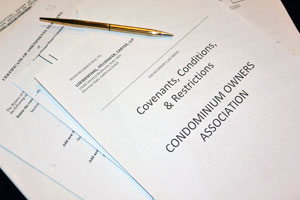Tesoro del Valle Master Homeowners Association v. Griffin
This case involves the enforcement of architectural restrictions in an association’s governing documents as against proposed installation of solar panels by an owner of a home within a planned unit development.
Griffin was the owner of a home within the Association who submitted an application to be allowed to install 22 solar panels on his lot on a slope which was outside a perimeter wall enclosing part of his property. The Association’s architectural committee rejected the Owner’s application on a number of grounds which were both procedural and substantive. Procedurally, the committee denied the application because it did not provide all the requisite information called for in the guidelines, such as location, set backs, size of panels and related information. Substantively, the committee denied the application because the panels were to be located on a slope outside the enclosed yard of the owner (which the CCRs precluded modification of), visible from the common area entry into the project and other homes therein.
The Owner proceeded to install the solar panels despite the denial of the application so the Association filed a lawsuit seeking an injunction to compel removal and for breach of the CCRs for installation of the system without express committee approval. The Owner filed a cross-complaint, alleging that the Association had violated California Civil Code Section 714, because part of the reason the application had been denied related to aesthetic considerations which were part of the architectural review process and guidelines and because the Association had not proposed a comparable alternative system.
Civil Code Section 714 prohibits restrictions on installation of solar energy systems which “significantly increase the cost of the system or significantly decrease its efficiency or specified performance, or which allow for an alternative system of comparable costs, efficiency, and energy conservation..” At trial, the Association introduced expert testimony demonstrating that locating 16-20 panels on a guest house roof within the enclosed yard, would cost less and only reduce output by 14%, would be easier to install and avoid interference with the slope. A jury found that the CCRs imposed reasonable restrictions that did not violate Section 714 generally or because aesthetic considerations were part of the analysis.
The Court of Appeals affirmed the jury’s decision in favor of the Association, relying on a prior appellate decision in Palos Verde Homes Assn. v. Rodman wherein guidelines primarily involving aesthetic considerations were found to be reasonable and met the standards of Section 714 (related to costs and efficiency.) The court ruled that the mere fact that the guidelines included aesthetic considerations did not make them unreasonable and further ruled that the Association was not obligated under the statute to propose a comparably priced alternative system.
IMPORTANCE OF THIS CASE: That aesthetic considerations in guidelines for approval of solar energy installations are not per se violations of Section 714 and may be enforced.
Larson v. Las Posas Hills Homeowner Association
This case deals with a unique situation where an Association member affirmatively intervenes in a lawsuit by another member against the Association which contests the Architectural Committee’s denial of an architectural application and the Board’s denial of the owner’s appeal.
Larson submitted an application to the Association’s architectural committee to construct a two story house on his lot. The committee denied the application because the proposed residence would block the view of his neighbor, Michael Rolls. The denial was appealed to the Board, which also denied the application. Larson then sued the Association, alleging breach of fiduciary duty, negligence and nuisance. The Association’s legal counsel suggested that Rolls might want to intervene in the case, since his view interests could be directly impacted by the outcome of the case.
Intervention is a legal process whereby a third party is allowed by the court to become a party to a pending action between others based on an inherent interest in the outcome of the case. The intervention was permitted by the court based on Rolls’ interest in preserving his views, which were protected by the CCRs of the Association.
At trial, the Association and Rolls prevailed and both sought attorneys fees and costs from Larson, based on Civil Code Section 1354 which provides that reasonable attorneys fees shall be recoverable by the prevailing party in an action to enforce the CCRs. There is no specific provision authorizing recovery by an intervening party.
Larson argued that Rolls was not entitled to recover fees because he was not enforcing the CCRs, that was handled by the Association, who would adequately protect his interests. The trial court ruled that Rolls was entitled to fees as a prevailing party because as an individual, Rolls, as a party to the CCRs was entitled to concurrently enforce the CCRs protecting his views along with the Association. The court ruled that the function of intervening is to reduce multiple lawsuits and delays by inclusion of affected parties in a single action. When Rolls was found to have a legitimate basis to intervene, he was entitled to the same procedural remedies of the other parties.
IMPORTANCE OF DECISION: The concept of individuals, either on the same side or against an Association adds an entirely new dimension to potential liability for attorney’s fees in cases concerning approvals or denials of architectural applications and other enforcement actions.
Schuman v. Ignatin (2010) 191 Cal. App. 4th 255.
This case involves a dispute between two owners concerning a view restriction. Two neighbors sought to prevent approval of proposed construction by another owner because the construction would impair a scenic view. The owner who proposed new construction contended that the Association’s CCRs were no longer valid because a document purporting to extend the term of the CCRs in 1998 was not signed by all the owners within the common interest development. The owners who objected to the construction contended that all owners did not have to execute the extension document.
The Court ruled that the CCRs remained enforceable because the challenge to the validity of the extension was not made within 4 years after the extension was recorded. Relying upon the 2009 case Costa Serena Owners Coalition v. Costa Serena Architectural Committee, 175 Cal. App. 4th 1175, the Court held that the statute of limitations of four years on challenging the effectiveness of the extension had expired nearly six years prior.
IMPORTANCE: Challenges to the enforceability of CCRs or provisions therein must be made within four years of recording or they will be forever barred.
Yan Sui v. Price (2011) 196 Cal. App. 933
Sui filed a lawsuit against his neighbor and his Association alleging that a parking restriction in the Association’s rules prohibiting inoperable vehicles being kept on assigned owner parking spaces was discriminatory, provided an unreasonable enforcement remedy (towing) and were unenforceable because the rules were not recorded.
The Court of Appeals rejected each of these arguments, ruling that “there is nothing unreasonable about prohibiting the open, long-term parking of disabled vehicles. The association was perfectly reasonable in prohibiting this unsightly intrusion upon the aesthetics of their common interest development.” Further, the court found that it was not inappropriate to tow violating vehicles since Vehicle Code Section 22658 specifically provided just such a means of enforcement. The court also rejected the argument that the rules had to be recorded to be enforceable.
IMPORTANCE: The test for the enforceability of an operating rule is the same for a CCR provision: reasonableness.
Ferwerda v. Bordon (2011) 193 Cal. App. 4th 1178
This case involved a challenge to a denial of an architectural application. Pursuant to the CCRs, the committee adopted a set of guidelines which included a provision that the committee could recover its reasonable attorney’s fees and costs if it was required to enforce the provisions of the architectural guidelines. However, the CCRs did not contain a provision authorizing the recovery of attorney’s fees.
The trial court ruled in favor of the committee on the merits of the denial and awarded the committee its attorney’s fees. On appeal, the Court determined that the committee, taking its authority to promulgate rules from the CCRs which did not provide for attorney’s fees, did not have the power to create a remedy that was not already in the CCRs.
IMPORTANCE: Operating rules can be used to interpret or effectuate provisions or remedies contained in the CCRs but cannot expand on the available remedies. The only way to modify or expand on remedies for a violation is through a CCR amendment.
Dover Village Association v. Jennison (2010) 191 Cal. App. 4th 123
This case involves a dispute over whether a building component should be considered “common area” or “exclusive use common area” for purposes of determining responsibility for costs of repairing the component and related damage. In this case, the Association classified a sewer pipe embedded in the building foundation beneath an owner’s unit as exclusive use common area and billed the owner for the cost of repairing the sewer pipe. The owner refused to pay for the repairs and the Association filed a lawsuit to collect.
The basis for the Association’s position was that this sewer pipe exclusively serviced the owner’s condominium unit. At trial, the court found that the sewer pipe was common area and not exclusive use common area. Its reasoning was that the CCRs only identified two building components as exclusive use, patios and garages and if the sewer pipe was intended to be exclusive use, it would have been specifically identified. Further, the court held that the sewer pipe was not a “fixture” of a single unit because it was connected to other units. The Association had argued that pursuant to Civil Code Section 1351, the sewer was a “fixture” serving only the owners unit. The court found that reliance of Section 1351 was not appropriate because the CCRs provided otherwise in limiting exclusive use common areas to garages and patios. In other words, the items listed in Section 1351 do not become exclusive use common areas if the CCRs specifically identify what constitutes exclusive use common areas.
IMPORTANCE: Many associations, in an attempt to delegate financial responsibility for maintenance, repair and replacement, inappropriately torture the term and concept of exclusive use common area to accomplish that. Many attorneys, in an attempt to appease their clients do the same, at least partially because it is a largely undefined concept. This case clearly identifies the proposition that if CCRs identify components which are exclusive use, then Section 1351 items cannot also be exclusive use common area components. This issue also arises commonly when the term “utility installation” is used in CCRs such that Association’s improperly interpret “utility installation” to include water supply pipes, waste lines or electrical conduit within walls.
Astralis Condominium Association v. Secretary, US Dept. of Housing and Urban Development, (2010) 620 F. 3d 62
This federal case out of Puerto Rico involved an alleged violation of the Federal Fair Housing Amendments Act by a condominium association that refused to “reasonably accommodate” handicapped persons who wanted the Association to allow them to exclusively use designated handicapped parking spaces closer to his unit instead of the deeded parking spaces for his unit which were farther away. As in most complexes, the handicapped spaces are required by local statute and are available on a first come, first served basis for visitors. It appears that the plaintiffs were already afflicted with their handicaps when they purchased their unit, thus knowing that their parking was going to be limited to their assigned spaces.
One argument made by the Association was that under applicable law, the Association could not legitimately transfer common area (handicapped spaces) to owners without the consent of the owners within the development. The court rejected this argument indicating that the federal law preempted local statutes and that the Association had to comply with the federal law of accommodation, even if to do so would violate a local law.
IMPORTANCE: In California, complaints made under the FHAA are handled by the California version of the federal agency, because the state law regarding disability and discrimination are relatively the same. Consequently, this situation is likely to come up and Boards/Managers need to be aware that they may be forced to violate the governing documents in order to comply with the requirement of “reasonable accommodation.”
Cabrera v. Alam 197 Cal.App.4th 1077 (2011); Countryside Villas HOA v. Ivie
The actual fact patterns of these two cases are not as important as the legal principles which are addressed therein. These cases both involve application of Code of Civil Procedure Section 425.16, which prohibits litigation that infringes upon constitutional rights of free speech. (anti-SLAPP-STRATEGIC LAWSUIT AGAINST PUBLIC PARTICIPATION) Cabrera involved an action by one candidate for the board against another for defamatory comments (slander) made in the course of an election debate. Countryside involved an action by an Association against an owner who was particularly critical of the Board’s decision to have the Association assume significant exterior maintenance responsibility which previously was that of the owners of units. The Association sought to confirm the correctness of the Board’s interpretation of the governing documents and related change in the Association’s maintenance policies through a declaratory relief action. The anti-SLAPP statute is designed to eliminate lawsuits brought in order to quash the exercise of free speech, very early in the process and with significant sanctions.
The essence of both these cases illustrates that courts have treated and will treat “speech” that occurs in the context of an Association meeting or communication, as constitutionally protected because Association meetings and communications are public and because Boards of Directors are considered “quasi-governmental bodies.”
IMPORTANCE: Boards of Associations must be cognizant that criticisms made by members against the Board or its policies may be constitutionally protected and as such the Board cannot use litigation as leverage to stop or quiet such criticism, even if the speech is false or nasty.


